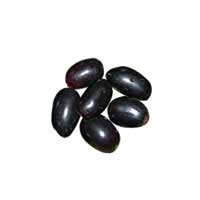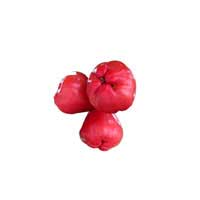 Full List of Fruits
Full List of Fruits  Jambul Fruit
Jambul FruitJambul Fruit
Scientific name - Syzygium cumini
Syzygium cuminiis is an ever green tropical tree that has been grown abundantly in Florida. It is a slow growing species that can reach to the maximum height up to 30 m and has a maximum life span of about 100 years. The fruit has rich content of vitamin A and C and it is also used in preparing wine and vinegar. The tree has a rough base and appears in dark grey in color.
![]() Nutritional Value of Jambul Fruit
Nutritional Value of Jambul Fruit
| Nutritional value per 100 g (3.5 oz) | |
|---|---|
| Energy | 251 kJ (60 kcal) |
| Carbohydrates | 14 g |
| Dietary fibre | 0.6 g |
| Fat | 0.23 g |
| Protein | 0.995 g |
| Vitamins | |
| Thiamine (B1) | (2%) 0.019 mg |
| Riboflavin (B2) | (1%) 0.009 mg |
| Niacin (B3) | (2%) 0.245 mg |
| Vitamin B6 | (3%) 0.038 mg |
| Vitamin C | (14%) 11.85 mg |
| Trace metals | |
| Calcium | (1%) 11.65 mg |
| Iron | (11%) 1.41 mg |
| Magnesium | (10%) 35 mg |
| Phosphorus | (2%) 15.6 mg |
| Potassium | (1%) 55 mg |
| Sodium | (2%) 26.2 mg |
| Other constituents | |
| Water | 84.75 g |
![]() Health Benefits of Jambul Fruit
Health Benefits of Jambul Fruit
It helps to improve digestion and acts as an initiator of liver and spleen process.
Helps in healing urinary diseases and diabetes.
Enhance blood purification and cures anemia.
Prevents diarrhea & dysentery.
Relives constipation, helps improve digestive power.
Breaks renal stones.
The fruit possess rich content of Glucose, Fructose, Vitamins C & A, riboflavin, nicotinic acid, folic acid, sodium, potassium, calcium, phosphorus, manganese, zinc and iron.
Tannin, gallic acid, resin, phytosterols are highly present in its stem & bark.
The seed contains the glycoside, jamboline, gallic acid and essential oils.
The flower has traces of terpenoids.
 Jamun has to be consumed after meals
Jamun has to be consumed after meals
 People who suffer severe nausea are advised not to eat the fruit.
People who suffer severe nausea are advised not to eat the fruit.
 Sprinkle salt over the jamun before consuming it.
Sprinkle salt over the jamun before consuming it.
 Intake of the fruit in large quantity may cause hyperacidity.
Intake of the fruit in large quantity may cause hyperacidity.
 Avoid drinking milk after eating jamun.
Avoid drinking milk after eating jamun.
The jambul is grown abundantly in the southern parts of Asia and in some regions of Australia. The species grows well in areas which receive high rainfall ranging between 1,500 -10,000 mm per year. The temperature of 2.5°C to 17.5°C has to be suitably maintained in getting the plant grown in a healthier way.


















